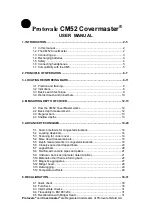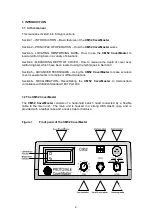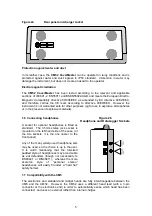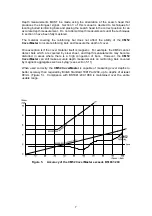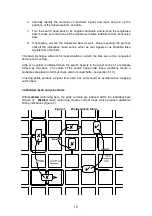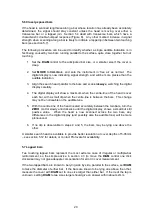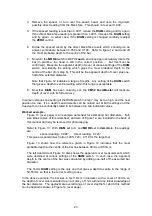
14
5. ADVANCED TECHNIQUES
5.1 Search method for congested situations
When the reinforcing bars are laid in an unknown pattern, especially if they are close
together or are partly joined by wires or stirrups, this can create difficulties in locating the
bars and measuring their depths.
Where signals are confusing and no clear pattern emerges from a simple scan, the most
reliable technique is to start from the locations giving
minimum
signal. This will always
occur in the spaces
between
the bars, and such a minimum will be unaffected by the
orientation of the search head. Having scanned the surface and marked out the centres of
the spaces between the bars, it then becomes much easier to use the techniques of
section 3 to identify where the bars truly are.
5.2 Locating deep bars
To locate deep bars, set the
DIAM
control to a position smaller than the expected bar
diameter, or all the way back to 5.
Set the
MODE
control to
CALib
rate and zero the digital display as usual. Take particular
care to do this well away from metal objects.
The digital display is now indicating signal strength, and an increase of as little as +002 or
+003 is a clear indication of the presence of metal.
Scan in the usual way, keeping a close watch on the display.
CAUTION – the instrument will also react slightly to shallower bars to the sides of the
search head, and also to transverse bars.
5.3 Scanning for under-cover
The
CM52 CoverMaster
can be used to scan a surface and indicate only those bars which
have less than a specified minimum depth of cover.
To set up for this mode of operation, turn the
MODE
switch
to LOCate
and the
DIAM
switch to 2-3 clicks smaller than the true bar diameter.
To set minimum cover, either use a bar which is known to have the minimum acceptable
cover, or else use a 500-1000mm length of bar of the correct diameter with a wood or
plastic spacer to establish the distance (do this away from other metal). In either case,
position the search head for maximum signal (section 3.2) and then turn the
ZERO
control
counterclockwise until the tone drops to a steady ticking.
Make certain that the controls - especially the
ZERO
knob - are not touched after setting
up.
Now scan the concrete in the usual way, keeping the search head parallel to the line of the
bars being investigated, and avoiding transverse bars. The
CM52 CoverMaster
will
remain almost silent over bars with more than the minimum acceptable cover, but will
‘squeal’ for bars with less.

